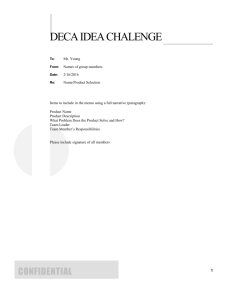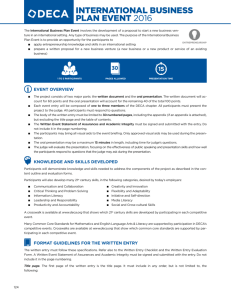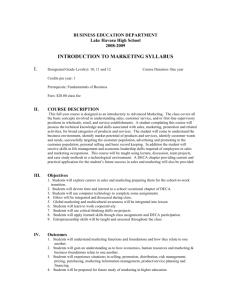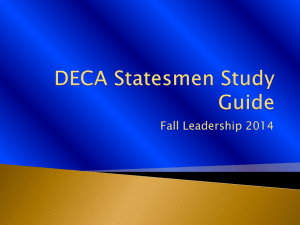File
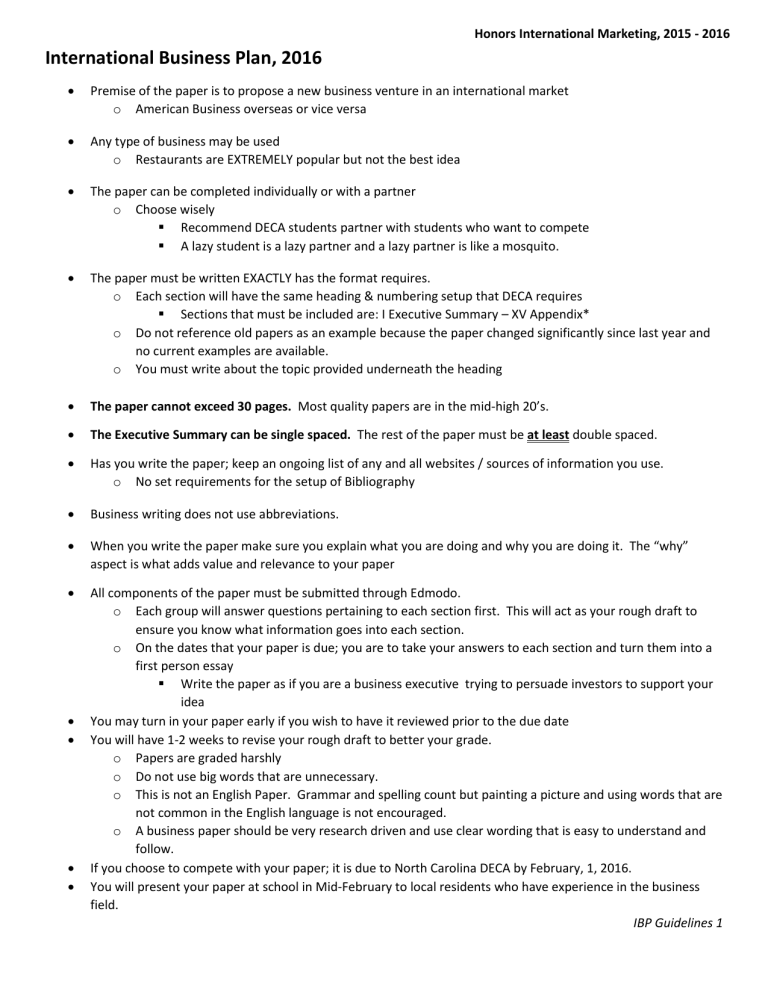
Honors International Marketing, 2015 - 2016
International Business Plan, 2016
Premise of the paper is to propose a new business venture in an international market o American Business overseas or vice versa
Any type of business may be used o Restaurants are EXTREMELY popular but not the best idea
The paper can be completed individually or with a partner o Choose wisely
Recommend DECA students partner with students who want to compete
A lazy student is a lazy partner and a lazy partner is like a mosquito.
The paper must be written EXACTLY has the format requires. o Each section will have the same heading & numbering setup that DECA requires
Sections that must be included are: I Executive Summary – XV Appendix* o Do not reference old papers as an example because the paper changed significantly since last year and no current examples are available. o You must write about the topic provided underneath the heading
The paper cannot exceed 30 pages. Most quality papers are in the mid-high 20’s.
The Executive Summary can be single spaced. The rest of the paper must be at least double spaced.
Has you write the paper; keep an ongoing list of any and all websites / sources of information you use. o No set requirements for the setup of Bibliography
Business writing does not use abbreviations.
When you write the paper make sure you explain what you are doing and why you are doing it. The “why” aspect is what adds value and relevance to your paper
All components of the paper must be submitted through Edmodo. o Each group will answer questions pertaining to each section first. This will act as your rough draft to ensure you know what information goes into each section. o On the dates that your paper is due; you are to take your answers to each section and turn them into a first person essay
Write the paper as if you are a business executive trying to persuade investors to support your idea
You may turn in your paper early if you wish to have it reviewed prior to the due date
You will have 1-2 weeks to revise your rough draft to better your grade. o Papers are graded harshly o Do not use big words that are unnecessary. o This is not an English Paper. Grammar and spelling count but painting a picture and using words that are not common in the English language is not encouraged. o A business paper should be very research driven and use clear wording that is easy to understand and follow.
If you choose to compete with your paper; it is due to North Carolina DECA by February, 1, 2016.
You will present your paper at school in Mid-February to local residents who have experience in the business field.
IBP Guidelines 1
Structure of the Paper
A title page & table of contents are required o Complete this aspect last o These two pages are not numbered and do not count towards your 30 page limit o All title pages must be setup as follows
INTERNATIONAL BUSINESS PLAN EVENT
Ardrey Kell DECA
Ardrey Kell High School
10220 Ardrey Kell Road
Charlotte, North Carolina 28226
Names of participants
February 1, 2016
Executive Summary can be 1-3 pages o An overview of what your business plan entails o DECA has merged the executive summary (1 page) with the introduction section from the previous paper to form the new Executive Summary o Is what gets read first and most often. o Must be interesting, informative, and persuasive. o This is the part of the paper that wins a judge and gains support
ANALYSIS OF THE INTERNATIONAL BUSINESS SITUATION
A. Economic, political and legal analysis of the trading country
1. Describe the trading country’s economic system, economic information important to your proposed business/ product/service, the level of foreign investment in that country (4.2)
Economic System: Market, Mixed (Capitalism / Socialism), Planned, & Traditional (p.87)
Foreign Direct Investment: The purchase of assets in a foreign country by a business. Can include land, property, or ownership in a foreign company.
Example: When Japan purchases land in Kentucky to start a manufacturing plant.(p. 267)
2. Describe the trading country’s governmental structure and stability, how the government controls trade and private business (2.2, 4.1, 4.3, 5.1)
Government Structure: Democracy, Republic, One-Party States, Theocracy (p.90)
Trade barriers: Arguments for trade barriers (p.33) Intellectual Property Rights (p. 135),
3. Describe laws and/or governmental agencies that affect your business/product/service [i.e., labor laws, trade laws (U.S.A. and/or Canada and foreign)] (4.2 & 12.1)
Trade Laws/Agreements: NAFTA, CAFTA, COMESA, CACM, CARICOM, & FTAA (p.87)
Labor Unions p.285
IBP Guidelines 2
B. Trade area and cultural analysis
1. Geographic and demographic information, important customs and traditions, other pertinent cultural information, competitive advantages and disadvantages of the proposed product and/or service (3.1,
3.2, 3.3, 5.1, 6.1)
Segmentation Variables: Demographics, Cultural / Psychographics, Geographic, & Product Usage /
Behavioral. (p.106)
Cultural Differences: High Context v. Low Context Cultures (p.53), Beliefs & Religion (p.56) Customs &
Bribery (p.65). Gift Giving (p. 65), Meeting Basics & Negotiations (p.67)
Competitive Advantage: p.130
2. Market segment analysis target market (age, income level, population estimate, other specific demographic and economic information) customer buying behavior related to the proposed product and or service (5.1)
Target Market for Product: Segmentation Strategy (Undifferentiated, Differentiated, & Concentrated p.105)
Segmentation Variables: Demographics, Cultural / Psychographics, Geographic, & Product Usage /
Behavioral. (p.106)
3. Analysis of the potential location—importance and requirements of each trade document required by the U.S.A. and/or Canada and the country of choice (8.2)
Trade Documents: Bill of Lading & Certificate of Origin (p.187) Profoma Invoice (Look online)
PROBLEM: List the top three problems your product/service is addressing. o List exactly three reasons as to why your product or service has a demand in the market you’ve selected. o Clearly explain why your product will be successful overseas due to the purpose it fulfills o Basically, what are the issues that exist in the International Market you chose; that your product or service will address
Customer Segments o Detail a primary and secondary target market o Segmentation Variables: Demographics, Cultural / Psychographics, Geographic, & Product Usage /
Behavioral. (p.106)
UNIQUE VALUE PROPOSITION o What is the single, clear, compelling message that states why your product/service is different and worth buying?
Be concise in your reasoning: “Best words, Best order.”
SOLUTION o What are the top three features of your product/service?
List exactly three features of your product/service
Features are surface statements of a product that explain what your product does, its dimensions, specs, and so on.
IBP Guidelines 3
CHANNELS (8.1 – 8.3) o What are the pathways to customers?
Short or Long channel of distribution?
Direct v. Indirect
Just in Time (JIT) Inventory Systems
Exclusive, Selective, & intensive
Export Management Companies (184)
Methods of Distribution (p. 189)
Types of retailers (p. 193)
REVENUE STREAMS
A.
What is the revenue model? a.
What is your framework for generating revenues? (links) i.
A. Commerce and retail
B. Subscriptions and usage fees
C. Licensing
D. Auctions and bids
E. Advertising
B.
What are the life time values? a.
What is the projected revenue that a customer will generate during their lifetime?
i.
Take the revenue you earn from a customer and subtract out the money spent on acquiring and serving them.
C.
What is the revenue? a.
List / Explain what your total revenue will be
D.
What is the gross margin? a.
Example:
COST STRUCTURE
A.
What are the customer acquisition costs? a.
What is the amount spent on trying to convince a customer to buy a product / service
Where:
CAC
= Cost of customer acquisition
CA
= Total customers acquired
MCC
= Total marketing campaign costs related to acquisition (Not retention)
B.
What are the distribution costs? (p. 188 – p. 190) a.
Free On Board, CIF: Cost, Insurance, Freight, b.
Types of transportation used (Water, Air, Land, Pipelines)
C. What are the human resources costs? (p.132)
Includes the costs of both management & labor
D.
Additional costs?
IBP Guidelines 4
DETAILED FINANCIALS (A-F are the same Sections as previous years. Look at Examples.) o Use Excel for Calculations
A. Projected income statements by month for the first year’s operation (sales, expenses, profit/loss)
B. Projected cash flow for the first year
C. Projected cash flow by month for the first year’s operation
D. Projected balance sheet, end of first year
E. Projected three-year plan
F. A brief narrative description of the planned growth of the proposed business, including financial resources and needs
G. Proposed plan to meet capital needs
1. Personal and internal sources
2. Earnings, short-term and long-term borrowing, long-term equity
3. External sources
4. Short-term and long-term borrowing, long-term equity (if applicable)
5. Repayment plans
6. Plan to repay borrowed funds or provide return on investment to equity funds
KEY METRICS o What are the key activities that must be measured?
COMPETITIVE ADVANTAGE o What about your product/service means that it cannot be easily copied or bought? ( p.130)
CONCLUSION o Specific request for financing, summary of key points supporting the financial request o Think Shark Tank “I am offering 10% of our company for $4 million)
BIBLIOGRAPHY o Does not have to be formatted a specific way o Track as you go on a separate sheet
APPENDIX o An appendix is optional. o Include in the appendix any exhibits appropriate to the written entry but not important enough to include in the body; these might include sample questionnaires used, letters sent and received, general background data, minutes of meetings, etc.
IBP Guidelines 5
